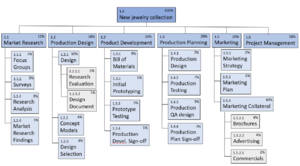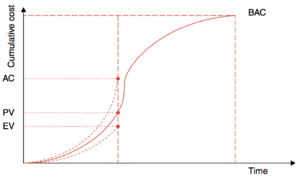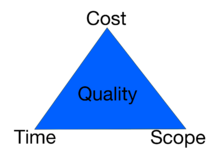Earned Value Analysis : A tool for decision-making
The Earned Value Analysis (EVA) Is a method used in Project Managment for monitoring the performance and progress of a project through a comparison of the planned project and the actual project. Measurements of the three components of the Project management triangle, Time, Cost & Scope are used as input in the analysis to create an objective estimate of the project's health. The purpose of EVA is to enable the project manager to make informed decisions based on objective results that are directly derived from the project's main performance indicators Time, Cost & Scope.
Contents |
History
The Earned Value Analysis, initially named PERT/COST was first used by the US government in the 1960s as the tool was imposed onto the contractors of the US Department Of Defense as a way of standardising the performance tracking of all the departments different projects. PERT/COST generated a large discontent amongst the contractors due to it's inefficiency and was ultimately changed by the US Department Of Defense in the late 1960s. From this a new analysis arose called Cost/Schedule Control Systems Criteria (C/SCSC) which is the criterion based approach that is now used widely through all of project management and known as the Earned Value Analysis (EVA) which further led to the practice of Earned Value Management (EVM)
Overview
EVA is a dynamic project management tool that allows a project manager to measure or forecast the performance of a project at any given time throughout the lifetime of a project. it's use of quantitative performance indicators makes it an objective tool which can be utilised in any scenario. The tool EVA is the fundamental element in the so called Earned Value Management (EVM) which is a management methodology in which a project is administered through decisions based on the results of the EVA. The methodology is widely used in the industry because of it's ability to facilitate informed objective decision-making and it's flexibility stemming from the time related inputs and outputs.
Depending on the size and complexity of the project the EVA might need different features in order to produce an adequate analysis of the project.
To perform a basic Earned Value Analysis the following features are required :
Adequate measurements from the following project indicators must be available.
- Time
- Cost
- Scope
Prerequisites for EVA
- A project plan, containing all the tasks of the project along with the time schedule (eg. Gantt chart )
- An estimate of the cost of each task within the project plan also known as "budgeted cost of work scheduled" (BCWS) or "Planned value (PV)
- An overview of the "Budgeted Cost Of Work Performed"(BCWP) or "Earned Value" (EV)
Terms & Definitions
When performing an EVA the following terms and definitions must be familiarised. In more specific cases eg. "EVA in Human Resource Management" more terms and definitions will be necessary to obtain the desired results. Therefore the following terms and definitions are the most commonly used ones.
| Name | Definition | Equation |
|---|---|---|
| Time of Review (TR) | The point in the total lifetime of the project at which the analysis is performed | |
| Budgeted Cost of Work Scheduled (BCWS) | The budgeted cost that is assigned at each step or task or as a cumulative value up until the Time of Review. (Also known as Planned Value (PV)) | |
| Budgeted Cost of Work Performed (BCWP) | The value that is earned from each of the steps or tasks in the project or as a cumulative value up until the Time of Review. (Also known as Earned Value (EV) ) | |
| Actual Cost of Work Performed (ACWP) | The actual cost of each step or task in the project or as a cumulative value up until the Time of Review. ( Also known as Actual Value (AV) ) | |
| Cost Variance (CV) | The variance between the earned value and the actual cost of a step or task in the project plan. A positiv value of the Cost Variance suggest a favourable impact on the project, and visa versa, a negative Cost Variance suggests an unfavourable impact. | ( CV = EV - AV )
or ( CV = BCWP - ACWP ) |
| Cost Performance Index (CPI) | The percentage of Earned Value over the Actual Cost. | ( CPI = EV / AV )
or ( CPI = BCWP / ACWP ) |
| Budget at completion (BAC) | The total budget of the project at the end of it's lifetime. | |
| Scheduled Variance (SV) | The variance between the earned value and the Planned Value of a step or task in the project plan. A positiv value of the Scheduled Variance suggest a favourable impact on the project, and visa versa, a negative Scheduled Variance suggests an unfavourable impact. | ( SV = EV - PV )
or ( SV = BCWP - BCWS ) |
| Schedule Performance Index (SPI) | The percentage of Earned Value over the Planned Value. | ( CPI = EV / PV )
or ( CPI = BCWP / BCWS )[1] |
| Critical Ratio (CR) | The product of CPI and SPI which is the final performance indicator for the project. A positiv Critical Ratio suggest a favourable impact on the project, and visa versa, a negative Critical Ratio suggests an unfavourable impact. | (CR = CPI  SPI) SPI)
|
Table 1: Common Terms & Definitions in EVA
Application


To apply the EVA firstly the BCWP & BCWS of the project must be obtained from the projects Work Breakdown Structure (WBS). The values are considered according to the Time of Review. If the Time of Review is not in the initial phase of the project, the ACWP should also be available and from that the CPI and SPI of the project can be calculated. This finally leads to the CR which will then determine the health of the project. If the EVA is performed and its results tracked as the project goes on, the trend of the different performance indicators can be determined and from this a valid forecast of the projects performance can be carried out.
If a project was managed using EVM with the results from the EVA being used as a benchmark for the different parts of the project. The Project manager would be able to evaluate every part of an entire project and determine it's impact on the project as a whole. This gives the project manager a unique ability to identify all the elements of the project that contribute to a decrease in the CR. The identified elements could then be reevaluated with regards to Cost, Time, and Scope, and a decision could then be made on whether to scrap, alter, or keep the identified underperforming element.
Limitations
When using a tool like the Earned Value Analysis it is important to be aware of its limitations. If a project is controlled using EVM many of the decision carried in the project will be made based on the results of the EVA. This means a wrong estimate of a cost or a prolonged project could be the tipping point between option A and B in a decision process. Which could ultimately lead to wrong decisions being made over the right decision. The uncertainty of data is therefore the biggest limitation of EVA [3]. It can also be concluded that as the project goes on, this limitation decreases as the unknown-unknowns of the project becomes fewer and the overall uncertainty of the the project decreases, Therefore this limitation is more relevant in the initial phase of a project.
Another limitation of the EVA are all the other factors that influence the project that can not be implemented into the Analysis. Country specific rules and regulations, Euro codes etc. These are all factors that can overrule a project optimisation decision proposed by the EVA. This means the EVA is restricted to what ever rules are imposed onto the project.
The organisational structure of the project and the different commitments through contracts could also be a limitation to the EVA being used as a decision making tool. Although an EVA could analyse a project and identifying the underperforming elements, they might not be subject to change since they are bond to the project by a contract. This could be an employee who is underperforming, or a subcontractor who is no longer needed. In this case the EVA is reduced from a decision making tool to a problem identification tool.
See also
Earned Value Management (EVM) in construction projects
Integrated Cost and Schedule Control
Bibliography
References
- ↑ 1.0 1.1 Baldwin, Andrew (2014-04-16). "A Handbook for Construction Planning and Scheduling". Retrieved June 12, 2017
- ↑ "http://CriticalTools.com". Retrieved June 21, 2017
- ↑ Alleman, Glen (2012-06-02). "Herding Cats : Issues with Deploying Earned Value Management". Retrieved June 12, 2017
